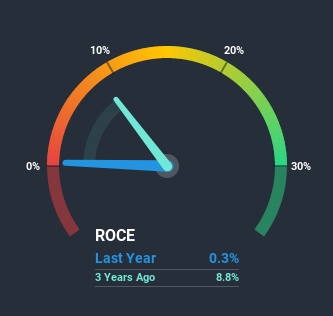- India
- /
- Semiconductors
- /
- NSEI:WEBELSOLAR
Can Websol Energy System (NSE:WEBELSOLAR) Continue To Grow Its Returns On Capital?

To find a multi-bagger stock, what are the underlying trends we should look for in a business? Typically, we'll want to notice a trend of growing return on capital employed (ROCE) and alongside that, an expanding base of capital employed. Ultimately, this demonstrates that it's a business that is reinvesting profits at increasing rates of return. With that in mind, we've noticed some promising trends at Websol Energy System (NSE:WEBELSOLAR) so let's look a bit deeper.
What is Return On Capital Employed (ROCE)?
Just to clarify if you're unsure, ROCE is a metric for evaluating how much pre-tax income (in percentage terms) a company earns on the capital invested in its business. To calculate this metric for Websol Energy System, this is the formula:
Return on Capital Employed = Earnings Before Interest and Tax (EBIT) ÷ (Total Assets - Current Liabilities)
0.0031 = ₹6.3m ÷ (₹3.1b - ₹1.0b) (Based on the trailing twelve months to March 2020).
Therefore, Websol Energy System has an ROCE of 0.3%. Ultimately, that's a low return and it under-performs the Semiconductor industry average of 0.7%.
See our latest analysis for Websol Energy System

Historical performance is a great place to start when researching a stock so above you can see the gauge for Websol Energy System's ROCE against it's prior returns. If you're interested in investigating Websol Energy System's past further, check out this free graph of past earnings, revenue and cash flow.
What Does the ROCE Trend For Websol Energy System Tell Us?
The fact that Websol Energy System is now generating some pre-tax profits from its prior investments is very encouraging. Shareholders would no doubt be pleased with this because the business was loss-making four years ago but is is now generating 0.3% on its capital. In addition to that, Websol Energy System is employing 210% more capital than previously which is expected of a company that's trying to break into profitability. We like this trend, because it tells us the company has profitable reinvestment opportunities available to it, and if it continues going forward that can lead to a multi-bagger performance.
In another part of our analysis, we noticed that the company's ratio of current liabilities to total assets decreased to 34%, which broadly means the business is relying less on its suppliers or short-term creditors to fund its operations. This tells us that Websol Energy System has grown its returns without a reliance on increasing their current liabilities, which we're very happy with.What We Can Learn From Websol Energy System's ROCE
To the delight of most shareholders, Websol Energy System has now broken into profitability. Given the stock has declined 12% in the last five years, there could be a chance of a good investment here if the valuation makes sense. That being the case, research into the company's current valuation metrics and future prospects seems fitting.
Since virtually every company faces some risks, it's worth knowing what they are, and we've spotted 5 warning signs for Websol Energy System (of which 2 make us uncomfortable!) that you should know about.
For those who like to invest in solid companies, check out this free list of companies with solid balance sheets and high returns on equity.
If you’re looking to trade Websol Energy System, open an account with the lowest-cost* platform trusted by professionals, Interactive Brokers. Their clients from over 200 countries and territories trade stocks, options, futures, forex, bonds and funds worldwide from a single integrated account. Promoted
Valuation is complex, but we're here to simplify it.
Discover if Websol Energy System might be undervalued or overvalued with our detailed analysis, featuring fair value estimates, potential risks, dividends, insider trades, and its financial condition.
Access Free AnalysisThis article by Simply Wall St is general in nature. It does not constitute a recommendation to buy or sell any stock, and does not take account of your objectives, or your financial situation. We aim to bring you long-term focused analysis driven by fundamental data. Note that our analysis may not factor in the latest price-sensitive company announcements or qualitative material. Simply Wall St has no position in any stocks mentioned.
*Interactive Brokers Rated Lowest Cost Broker by StockBrokers.com Annual Online Review 2020
Have feedback on this article? Concerned about the content? Get in touch with us directly. Alternatively, email editorial-team@simplywallst.com.
About NSEI:WEBELSOLAR
Websol Energy System
Manufactures and sells solar photovoltaic (PV) cells and modules in India.
Mediocre balance sheet low.

